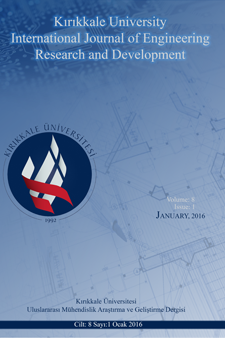Usage of antimony trioxide, aluminum hydroxide and zinc borate in GRP composite production as fire-retardant additives: An experimental research
Usage of antimony trioxide, aluminum hydroxide and zinc borate in GRP composite production as fire-retardant additives: An experimental research
Glass fiber, Fire retardant composites, Non-flammability, Tensile test,
___
- Bar, M., Alagirusamy, R., Das, A. (2015). Flame retardant polymer composites. Fibers and Polymers. 16, 705-717.
- Bulut , Y., Erdoğan Ü. H. (2011). Usability of cellulose based natural fibers as reinforcement materials in composite manufacturing. Journal of Textiles and Engineer. 82, 26–35.
- Camino, G., Costa, L., Cortemiglia, L. (1991). Polymer degradation and stability. Journals & Books. 33(2), 131-154. doi:10.1016/0141-3910(91)90014-I
- Carpentier, F., Bourbigot, S., Le Bras., M. (2000). Charring of fire retarded ethylene vinyl acetate copolymer magnesium hydroxide/zinc borate formulations. Polymer Degradation and Stability. 69 (1), 83–92. doi:10.1016/S0141-3910(00)00044-6
- Cullis, C.F., Hirschler., M.M. (1981). The combustion of organic polymers. Clarendon Press, Oxford. Dittenber, B.D., Gangaroa, V.S.H. (2006). Composites part a: Applied science and manufacturing. Journals & Books 43 (8), 1419-1429. doi:10.1016/j.compositesa.2011.11.019
- Guan, F.L., Gui, C.X., Zhang, H.B. (2016). Enhanced thermal conductivity and satisfactory flame retardancy of epoxy/aluminacomposites by combination with graphene nanoplatelets and magnesium hydroxide. Compos Part B: Eng. 98 (1),134–140.doi:10.1016/j.compositesb.2016.04.062
- Hong, C.H., Lee, YB. (2005). Tensile properties and stress whiting of polypropylene/polyolefin elastomer/magnesium hydroxide flameretardant composites for cable insulating application. Journal of Applied Polymer Science 97 (6), 2311–2318. doi:10.1002/app.21776
- Hornsby, P.R. (1994). The application of magnesium hydroxide as fire retardant and smoke-suppressing additive for polymers. Fire and Materials. 18, 269–276. doi:10.1002/fam.810180502
- Kaya, A.İ. (2016). Composite Materials and Their Properties.Putech & Composites Magazine.
- Maira, B., Chammingkwan, P., Terano, M. (2015). New reactor granule technology for highly filled nanocomposites: effective flameretardation of polypropylene/magnesium hydroxide nanocomposites. Macromolecular Materials and Engineering. 300 (7),679–683.doi:10.1002/mame.201500012
- Manfredi, B.L., Rodriguez, S. E., Wladyka-Przybylak, M., Vázquez, A. (2006). Thermal degradation and fire resistance of unsaturated polyester, modified acrylic resins and their composites with natural fibres. Polymer Degradation and Stability. 91 (2). 255-261. do:10.1016/j.polymdegradstab.2005.05.003
- Raghavendra, T., Kavan, P. (2018). A novel study on thermal stability of camphor soot reinforced coir fibers. Fibers and Polymers.19, 1567-1575. doi:10.1007/s12221-018-8033-2
- Saçak, M. (2005). Polymer Technology, 1th edition. Ankara
- Sain, M., Park, S.H., Suhara, F. (2004). Flame retardant and mechanical properties of natural fibre-PP composites containing Magnesium hydroxide. Polym Degrad Stab. 83 (2),363–367. doi:10.1016/S0141-3910(03)00280-5
- Sangcheol, K. (2003). Flame retardancy and smoke suppression of magnesium hydroxide filled polyethylene. Journal of Polymer Science Part B Polymer Physics. 41 (9), 936-944. doi:10.1002/polb.10453
- Sorathia, U., Rollhauser, C, M., Hughes, W.A. (1992). Improved fire safety of composites for naval applications. Fire and Materials. 16, 119-125. doi:10.1002/fam.810160303
- Tasdemir, M., Caneba, G.T., Tiwari, R. (2011). Characterization of PP/Mg(OH)2 and PP/nanoclay composites with supercritical CO2 (scCO2). Polymer-Plastics Technology and Engineering. 50 (10), 1064–1070. doi:10.1080/03602559.2011.557919
- Titelman, G.I., Gonen, Y. (2002). Discolouration of polypropylene-based compounds containing magnesium hydroxide. Polymer Degradation and Stability. 77 (2), 345–352
- Valery, V., Evgeny, I. (2001). Mechanics and Analysis of Composite Materials.
- Zhu, Z.M., Shang, K., Wang, L.X., Wang, J.S. (2019). Synthesis of an effective bio-based flame-retardant curing agent and its application in epoxy resin: Curing behavior, thermal stability and flame retardancy. Polymer Degradation and Stability. 167. 179-178. doi:10.1016/j.polymdegradstab.2019.07.005
- Yayın Aralığı: 2
- Başlangıç: 2009
- Yayıncı: -
Onur DOĞAN, Başak AYYAR, Gültekin CAGIL
İstanbul Havalimanı Yolcu Kapasitesinin Tahminine Yönelik Simülasyon Çalışması
Ahmet BEYCİOĞLU, Eda DOĞAN, Suna ÇETİN, Neslihan GÖKÇE, Hüseyin Yılmaz ARUNTAŞ
Rijit Bodrumlu Binaların TBDY 2018’e Göre Tasarımına Yönelik Bir Değerlendirme
Ali Ruzi ÖZUYGUR, Abdullah DİLSİZ
Deniz YERTUTAN, Tahsin ÇETİNYOKUŞ
Sezgisel Bulanık Kalite Fonksiyon Yayılımı ve Bir Uygulama
1500 V DC Beslemeli Raylı Sistemlerde Dinamik Reaktif Güç Probleminin DKS ile Çözümü
Ayşegül ÖZDEN ACEHAN, Ömer MERCİMEK, Rahim GHOROUBİ, Ozgur ANIL
